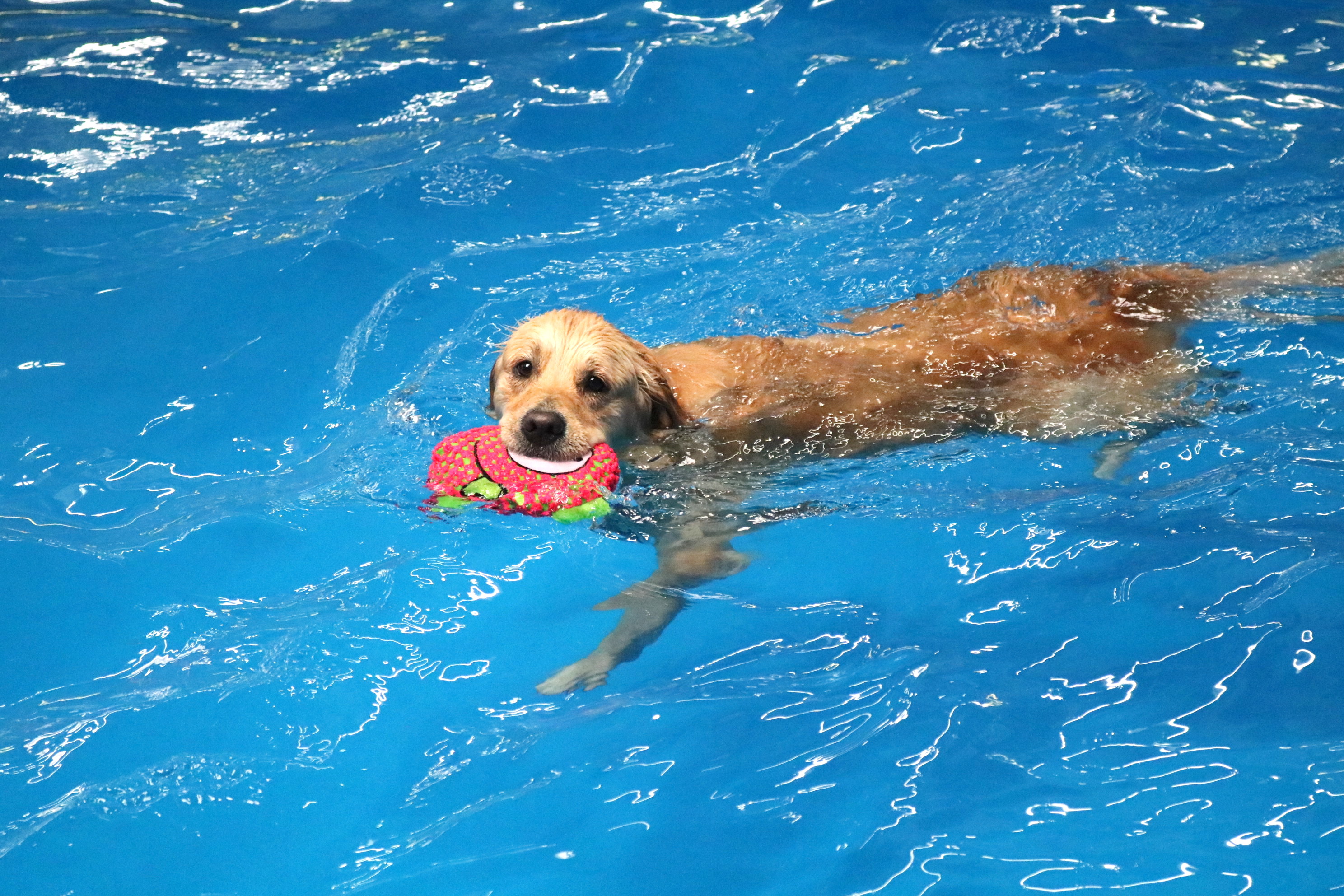by Leslie Gallagher McMahon, owner/founder of Two Hands Four Paws. Pet Physical Therapy and Animal Hydrotherapy Weight Management.
The call from Alex’s owner was typical. “My dog is somewhat overweight and needs to have surgery for a torn cruciate ligament, but the vet cannot do it until he loses some weight. Can you help us??” I replied that of course we could help and we set up an appointment. Alex turned out to be more than “somewhat” overweight. He was, in fact, absolutely enormous. For a golden retriever a good weight can be anywhere from 70-90 pounds give or take. Alex was 165. As soon as I saw him my heart sank, and I knew we had our work cut out for us. He desperately needed pet physical therapy.
Goldens are right up there with Labrador Retrievers as the breeds most predisposed to weight gain and torn cruciate ligaments, which is a ligament keeping the knee in place. Being as they are completely adorable as well, it is often hard for their owners to resist over-feeding them. There are so, so many things we as canine rehabilitation therapists can do (we cannot use the term physical therapy as that term is protected for humans only), but one of the hardest things to manage in the world of canine rehabilitation, is diet.
In 2025, most vets will tell you that they never, ever, ever tell their clients that their dogs or cats need to lose weight, even if the animals are grossly obese. Why? Because the fear is that most clients will be so offended that they will not come back. I was astonished when I heard that until I set up my own practice and found out for myself. I am pretty outspoken when it comes to weight as it is one of the absolutely easiest things in the world you can manage to keep your animals healthy. One pound of excess weight in a dog is the equivalent of five pounds for us, so even if your dog “only” needs to lose about ten pounds, that is like you or I having to lose 50 pounds!!!
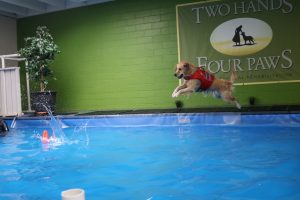 In addition to putting an overweight dog on a diet, one of the most helpful tools for keeping your dog fit is exercise via pet physical therapy. This is where we come in. Our goal in canine rehabilitation and more importantly in cases like these swim therapy, is to get your dog as active and healthy and pain free as we can, for the life of your dog. Even your very senior dog needs to get regular, fun exercise just as we do. Swimming your dog can be key to not only losing weight but keeping their joints healthy and free of arthritis. And for elderly dogs that have arthritis, it is a comfortable and easy way to get exercise without pain. The warmth of the water and the buoyancy allow painful joints to go through their full range of motion, something that is hard to do on land.
In addition to putting an overweight dog on a diet, one of the most helpful tools for keeping your dog fit is exercise via pet physical therapy. This is where we come in. Our goal in canine rehabilitation and more importantly in cases like these swim therapy, is to get your dog as active and healthy and pain free as we can, for the life of your dog. Even your very senior dog needs to get regular, fun exercise just as we do. Swimming your dog can be key to not only losing weight but keeping their joints healthy and free of arthritis. And for elderly dogs that have arthritis, it is a comfortable and easy way to get exercise without pain. The warmth of the water and the buoyancy allow painful joints to go through their full range of motion, something that is hard to do on land.
What are some of the benefits of keeping your dog athletic and fit? Your dog will be more coordinated (less risk of falling and injuring himself) and you will reduce the risk of injury. If your dog does get injured, his recovery will be faster. If you are able to keep his weight down, he will be more able to withstand stress (and yes, dogs do feel your stress all the time!!) and they will have an enhanced sense of well- being. The other bonus is that you get in a workout as well and have some wonderful bonding time with your dog!
What is an appropriate weight level for your pooch? You can either ask your vet (if they’ll tell you!) or feel their waistline. There is absolutely no benefit to a dog carrying around any extra weight, so you want to check their neck, ribs and rear end. Typically you want to see no excess skin/fat at any of these spots. You should be able to feel their ribs easily without having to press in too much. You also want to stand over your dog and see a visible tuck in their waistline.
And as mentioned above, regular quality exercise is very important for all dogs. Your dog should be able to comfortably do strength exercise for 15 minutes at a time at least 3 days a week. By strength exercise that can be anything from brisk walks to easy trotting if they are able, to swimming (with multiple breaks) to hiking, to even riding alongside you as you slowly ride your bike. Of course all of these activities should be worked up to gradually so that your dog builds endurance and doesn’t get injured.
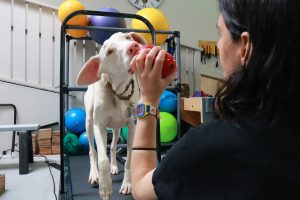 In the canine rehabilitation world we see some of the same injuries and orthopedic issues all the time. For example, take hip dysplasia. Hip dysplasia is a controversial problem but something that any dog owner can take steps to prevent. The causes of hip dysplasia are complex and can often be genetic and breed specific. German Shepherds, Golden Retrievers and Labradors for example are extremely prone to this disease. However you can be proactive in helping your dog by making sure your dog stays thin from a young age, as obesity is a major contributor to hip dysplasia, and by conditioning your dog to stay very fit. Slim, highly conditioned dogs are much less likely to develop hip dysplasia and if they do develop it, the severity of the disease is usually much less than that of overweight, de-conditioned dogs. In rehab we swim dogs every single day with this disease as it is a wonderful tool to help their range of motion and overall level of function. And for our Goldens and Labs once they become good swimmers you can almost never get them out of the pool!
In the canine rehabilitation world we see some of the same injuries and orthopedic issues all the time. For example, take hip dysplasia. Hip dysplasia is a controversial problem but something that any dog owner can take steps to prevent. The causes of hip dysplasia are complex and can often be genetic and breed specific. German Shepherds, Golden Retrievers and Labradors for example are extremely prone to this disease. However you can be proactive in helping your dog by making sure your dog stays thin from a young age, as obesity is a major contributor to hip dysplasia, and by conditioning your dog to stay very fit. Slim, highly conditioned dogs are much less likely to develop hip dysplasia and if they do develop it, the severity of the disease is usually much less than that of overweight, de-conditioned dogs. In rehab we swim dogs every single day with this disease as it is a wonderful tool to help their range of motion and overall level of function. And for our Goldens and Labs once they become good swimmers you can almost never get them out of the pool!
Another very common injury is the ruptured anterior cruciate ligament (ACL), which as mentioned above, is one of the ligaments keeping the knee stable. Many, many breeds are pre-disposed to ACL ruptures, among them Golden Retrievers, Rottweiler’s, Labradors, Newfoundland’s, Bulldogs, Poodles, Chihuahuas and Yorkshire Terriers. The most common cause of a ruptured ACL is what we call the “weekend warrior syndrome”. These are dogs that generally rest all week long while their owners are working, and then Saturday and Sunday go nuts at the dog park, go hiking in the canyons, race along the beach chasing seagulls, chase a Frisbee and chase squirrels. Oftentimes they are overweight and not in great shape athletically.
Pet Physical Therapy
Rehabbing these dogs is a complex process as most end up having to undergo surgery to stabilize the knee joint. What can you do to prevent your dog from rupturing an ACL? Just like hip dysplasia, the most important things are keeping your dog at a proper weight, keeping them on a regular exercise schedule, and be especially careful with your elderly dogs that you don’t initiate an athletic activity that is too intense or too difficult for their level of conditioning. No twisting, jumping, chasing Frisbees or tennis balls, all exercise should be careful and controlled and as non-impact as possible. I can’t say enough about swimming as the best modality for exercising your dog.
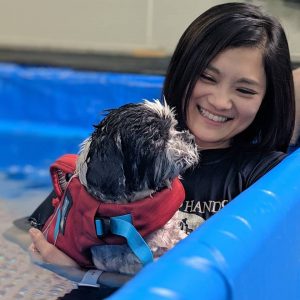 Pet Physical Therapy Works
Pet Physical Therapy Works
‘The last thing you need to know is where to find a good canine rehabilitation expert in your area. Not all veterinarians are familiar with canine rehab and we can be a wonderful tool in your arsenal to protect your pet in his senior years. Your canine rehab expert can teach you much about how to care for your pet and you’ll have a good quick resource to go to once you sense your dog is painful or not feeling well. And if a quick web search doesn’t yield a canine rehab therapist in your area, just email me ([email protected])! I’ll be happy to search one out for you. We are located in just about every state in the union, as well as all over the world. As canine rehab is still a fairly growing industry we all know each other, and are happy to refer whenever needed.
P.S. Alex got enough weight off to have his surgery and now he swims every day at home like a champ!
About the Author:
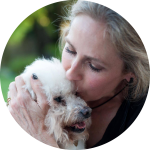 Leslie Gallagher McMahon is the owner/founder of Two Hands Four Paws, the premier canine physical rehabilitation center in Los Angeles. She and her staff practice state-of-the-art small animal rehabilitation, including modalities such as massage therapy, laser therapy, acupuncture, ultrasound and PEMF, and hydrotherapy in two water treadmills and a large saltwater pool. Her facility treats everything from osteoarthritis to torn cruciate ligaments, ruptured discs, dysplasia, cancer and obesity. Every single member of her rehab team is certified in canine physical rehabilitation. Her veterinarians and therapists treat an average of 50 animals/day. The full-sized pool is also used for weekly “Fun Swims” for animals who have either graduated from therapy or who just want to swim for exercise and to build/maintain cardio fitness. Leslie routinely lectures throughout the state of California on the benefits of canine PT. Fluent in Spanish, she has been featured many television and radio shows in the USA (Animal Planet, Fox, Univision) and on networks in France, Ireland, Germany, Japan and Egypt.
Leslie Gallagher McMahon is the owner/founder of Two Hands Four Paws, the premier canine physical rehabilitation center in Los Angeles. She and her staff practice state-of-the-art small animal rehabilitation, including modalities such as massage therapy, laser therapy, acupuncture, ultrasound and PEMF, and hydrotherapy in two water treadmills and a large saltwater pool. Her facility treats everything from osteoarthritis to torn cruciate ligaments, ruptured discs, dysplasia, cancer and obesity. Every single member of her rehab team is certified in canine physical rehabilitation. Her veterinarians and therapists treat an average of 50 animals/day. The full-sized pool is also used for weekly “Fun Swims” for animals who have either graduated from therapy or who just want to swim for exercise and to build/maintain cardio fitness. Leslie routinely lectures throughout the state of California on the benefits of canine PT. Fluent in Spanish, she has been featured many television and radio shows in the USA (Animal Planet, Fox, Univision) and on networks in France, Ireland, Germany, Japan and Egypt.
Additional Links:

